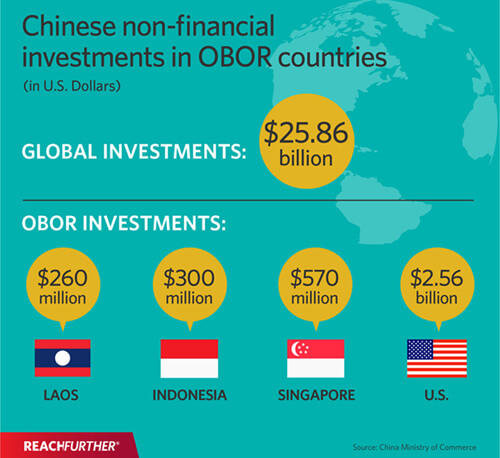U.S.-Asia Business
Belt and Road Initiative: Connecting the Economic Dots
By Melody Yuan

Infrastructure and investment opportunities that businesses should consider in 2018 and beyond.
The Belt and Road Initiative is slated to be one of the largest global infrastructure and investment projects in history. Recreating the old Silk Road has been a priority for the Chinese government since President Xi Jinping first announced the initiative in 2013. Known today as the One Belt, One Road Initiative or Belt and Road Initiative (BRI), this gargantuan project could reshape global trade routes as it grows to cover more than 65 countries, half of the world’s population, and about one-third of global GDP.
The underlying economic strategy is complexly tied to foreign policy, capital investment from public and private enterprises, and trade routes. At the core of the BRI, however, is China’s attempt to extend its presence in the global marketplace by supporting the economic development of neighboring countries. Spending around $150 billion annually in the countries that are participating in the BRI, China is wielding its commercial clout and investing heavily in foreign infrastructure.
“It’s bigger than the Marshall Plan, bigger than the Apollo mission, and bigger than the Great Wall of China,” says Sheryl WuDunn, co-author of “China Wakes: The Struggle for the Soul of a Rising Power” and cofounder of FullSky Partners, an advisory firm focused on double-bottom-line ventures in technology and healthcare. “This project is a visionary legacy from today’s Chinese leadership.”
Business opportunities and international participation
China has so far committed more than $1 trillion in building infrastructure around the BRI. Projects such as setting railway routes in Bangladesh, building refineries in Saudi Arabia and a new port city in Sri Lanka are just some of the ways that this initiative is taking shape. “Projects will stretch from China to as far as Finland and Poland,” says WuDunn.
While China is spearheading the BRI, it has encouraged international participation and the involvement of local governments. “China has reiterated that it doesn’t intend for this to be a solo show,” says Dominic Ng, chairman and CEO of East West Bank. “In fact, they see the BRI as a symphony and have invited other countries to join the orchestra.”
“Many of these countries involved are looking for targeted ways to improve infrastructure, update their software, and find opportunities to exchange information,” says Lincoln Leong, CEO of MTR Corporation, a Hong Kong company that runs the mass transit railway. “Even within the ASEAN countries alone, what we’re hearing is that in the next 10 years, the demand for infrastructure will be worth two to three trillion dollars.”

To date, some 50 state-owned enterprises (SOEs) have been involved with more than 1,700 BRI projects. While most of the beneficiaries are Chinese companies, some U.S. firms have jumped on the bandwagon.
“While the U.S. government hasn’t gotten involved, there are some smart private U.S. businesses like GE (General Electric), Honeywell, DOW Chemical, Caterpillar, etc., that see the benefit of getting in early,” says Ng. “You don’t necessarily have to run the BRI projects or even provide construction, but you can still sell equipment, goods, and services to some of the Chinese companies to generate profit.”
In recent news, China has also begun exploring the space frontier as part of its BRI project. Space technology and infrastructure in the form of satellites have begun to surface, with both state-run and private businesses branding their satellite launches with the BRI.
Challenges facing the BRI
Risks ranging from currency fluctuations to cultural differences must be overcome for the BRI to succeed as a cohesive corridor connecting China to the rest of the world.
“There are going to be many challenges for China with the BRI,” says Winston Ma, managing partner and chief investment officer of China Silkroad Investment Capital. “Keep in mind that many of these projects are going to involve a mix of public and private investments,” continues Ma, “so, if you think about some of the projects like the telecom initiatives that are bringing the internet to more rural areas, you’ll see that the public sector will focus more on the digital divide, whereas the private sector will seek more return on investments. This could cause a lot of friction.”
The question of bridging the cultural gap also poses a potential risk, as there has been increased regulatory scrutiny over sovereign investments. “But if you look back at China’s history, you’ll see that it has overcome tremendous challenges,” says Perry Wong, managing director of research at the Milken Institute. “This country has managed to lift millions of its own people out of poverty, and transformed into one of the strongest economic powerhouses today. Just think about the message that China is sending out to the people in Africa, Southeast Asia, and Latin America.”
While some of the BRI benefits include higher Chinese and foreign investments in countries that will help strengthen the local economy through job growth and better trade, the logistics surrounding the development of trade routes will also become a test for positive diplomacy and infrastructural efficiency. Rail routes are cheaper than air freight and still quicker than sea travel, but the involvement of various countries, businesses, and funds will require delicate delegation and sound decision-making. “The Organization for Economic Cooperation and Development (OECD) limits how much developed countries can impose on developing countries,” says Ma. “But since China isn’t a part of the OECD, we have yet to find out what the implications are for the failure of less developed countries to pay back China.”
The example of Sri Lanka defaulting on its $1 billion loan from China to build up the 8-year-old Hambantota deep-sea port on the country’s southern tip points to what could possibly go wrong for developing nations involved in the BRI. Unable to pay back their loan, Sri Lanka gave China a 99-year lease on the port for debt relief, which has been met with wide criticism.
Focusing on the big picture
“You’ll find that some of the BRI projects will fail,” says Ng. “It’s inevitable.” Important to note, however, is the necessity for many of these developing countries to have the proper infrastructure in place to emerge with a stronger economy.
“By and large, most of these projects have been deemed un-bankable because they cost billions of dollars to build and require many years to see a return on investment,” says Ng. “It comes with no surprise that [many] publicly traded or privately owned financial institutions would shy away from deals like this. The opportunity that the BRI presents for many of these countries is the fact that the Chinese government is willing to provide the financing that many private banks refuse to do.”
There is also a level of healthy competition that Ma believes will be positive for the global economy. “There is now more competition between China and Western countries,” says Ma. “Look at cell phone technology, for example. During the 4G era, China was playing a lot of catch up for network and mobile phone-related products. But the next phase of 5G technology is going to be much more interesting.” Chinese tech giants and U.S. tech giants are competing to identify and sell to the next avenue of consumers, which will undoubtedly come from emerging markets along the Belt and Road routes.
Other business cross-pollination opportunities involve e-commerce and retail, both of which have the potential to grow through the BRI. “Just look at China’s biggest online commerce event that takes place on November 11,” says Ma. “It’s a huge national shopping day called Singles’ Day, which happens only in China, but retail stores and vendors from other countries have benefited, too.” Sixty thousand international brands took part in the world’s biggest e-commerce event in 2017, but if retailers could more efficiently send out their goods and services to China, the event could potentially become a bigger global deal.
“I look at the current situation and think that U.S. companies should be more aggressive in finding various channels to get involved [in the BRI],” says Ng. “Hong Kong, for example, would be a good channel since they’re already out here advocating for ways to get U.S. businesses involved. Companies need to look at ways to participate now, because once some of the infrastructure is built, there will be a whole lot more business and commerce opportunities.”

